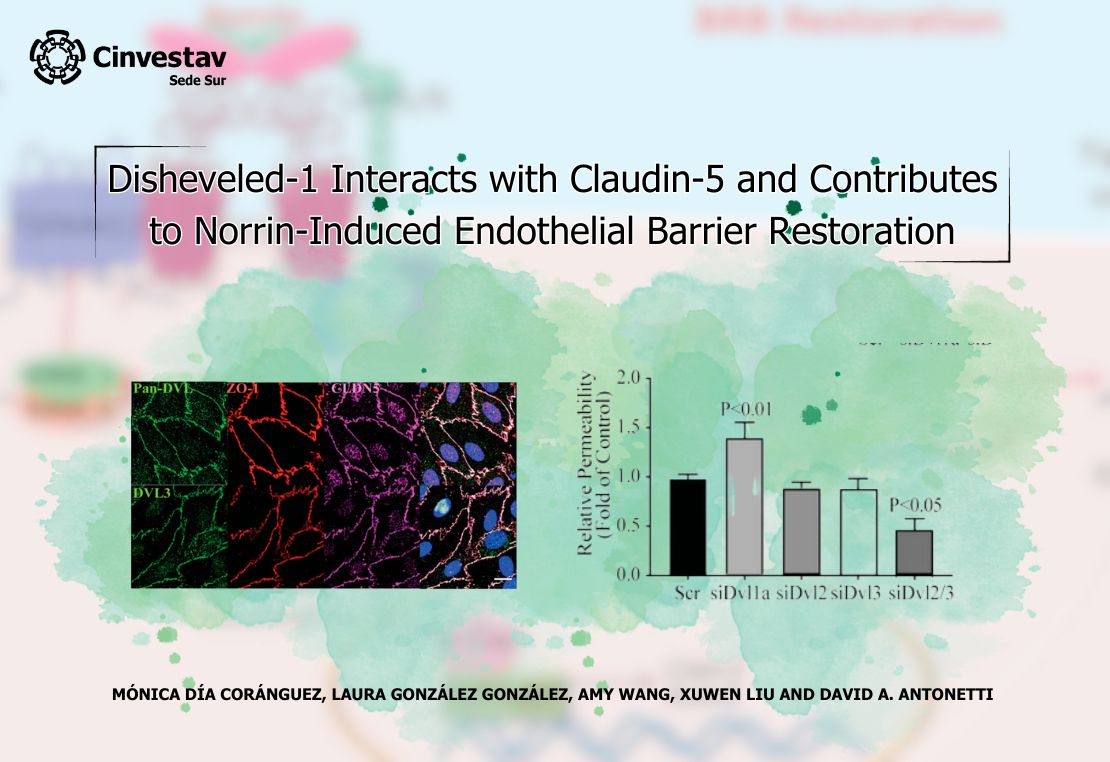Mónica Díaz Coránguez - Disheveled-1 Interacts with Claudin-5 and Contributes to Norrin-Induced Endothelial Barrier Restoration

4 de Octubre de 2023
Invitamos a leer el artículo: “Disheveled-1 Interacts with Claudin-5 and Contributes to Norrin-Induced Endothelial Barrier Restoration”, en la que colaboró la Doctora Mónica Díaz Coránguez, Investigadora de Cinvestav Sede Sur
Autores: Mónica Díaz Coránguez, Laura González González, Amy Wang, Xuwen Liu y David A. Antonetti
Felicitamos al estudiantado y profesorado que contribuyeron en esta investigación por su arduo trabajo.
Abstract: Previous studies have revealed that norrin can reverse vascular endothelial-growth-factor (VEGF)-induced permeability in a β-catenin-dependent pathway. Here, we have explored the contribution of disheveled-1 (DVL1) in norrin-induced blood-retinal barrier (BRB) restoration. We provide evidence that in addition to canonical signaling, DVL1 promotes tight junction (TJ) stabilization through a novel, non-canonical signaling pathway involving direct claudin-5 (CLDN5) binding. Immunofluorescence staining of rat retinal cross-sections showed enriched expression of DVL1 and 3 at endothelial capillaries and co-localization with CLDN5 and ZO-1 at the TJ complex in primary bovine retinal endothelial cells (BRECs). Barrier properties of BRECs were determined via measurements of trans-endothelial electrical resistance (TEER) or permeability to 70 kDa RITC-dextran. These studies demonstrated that norrin restoration of barrier properties after VEGF treatment required DVL1 as an siRNA knockdown of Dvl1 but not Dvl2 or Dvl3, reduced basal barrier properties and ablated norrin-induced barrier restoration. However, loss of Dvl1 did not decrease β-catenin signaling activity as measured by Axin2 mRNA expression, suggesting the contribution of a non-canonical pathway. DVL and TJ protein interactions were analyzed via co-immunoprecipitation of endogenous protein in BRECs, which demonstrated that DVL1 interacts with both CLDN5 and ZO-1, while DVL3 interacts only with ZO-1. These interactions were most abundant after inducing BRB restoration by treating BRECs with VEGF and norrin. DVL has previously been shown to form intramolecular bindings between the C-terminal PDZ-binding motif (PDZ-BM) with an internal PDZ domain. Co-transfection of HEK293 cells with DVL1 and CLDN5 or relevant mutants revealed that DVL1 interacts with CLDN5 through the DVL PDZ domain binding, CLDN5 PDZ-BM, in competition with DVL1 PDZ-BM, since DVL/CLDN5 interaction increases with deletion of the DVL1 PDZ-BM and decreases by co-expressing the C-terminal fragment of DVL1 containing the PDZ-BM or through deletion of CLDN5 PDZ-BM. In BREC cells, transfection of the C-terminal fragment of DVL1 downregulates the expression of CLDN5 but does not affect the expression of other proteins of the TJs, including ZO-1, occludin, CLDN1 or VE-cadherin. Blocking DVL1/CLDN5 interaction increased basal permeability and prevented norrin induction of barrier properties after VEGF. Combined with previous data, these results demonstrate that norrin signals through both a canonical β-catenin pathway and a non-canonical signaling pathway by which DVL1 directly binds to CLDN5 to promote barrier properties.
Keywords: blood–retinal barrier; disheveled; claudin-5; tight junction; norrin; endothelium; permeability; barriergenesis; retina; Wnt signaling